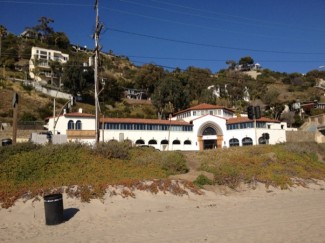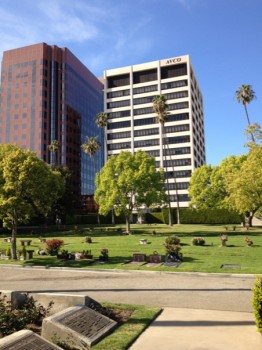
The following is the first in a series that will serve as the conclusion of the Kicking and Screaming blog.
The story of my ordination to the priesthood begins in a Los Angeles graveyard.
At the very end of the movie Pretty Woman — as Julia Roberts for all intents and purposes begins her film career and Richard Gere essentially closes out his (zing!) — a voice wafts over the streets of Southern California and proclaims, “Welcome to Hollywood! What’s your dream? Everybody comes here; this is Hollywood, land of dreams. Some dreams come true, some don’t; but keep on dreaming. This is Hollywood. Always time to dream, so keep on dreaming!”
When my plane arrived in the land of dreams for Spring Break in March, it had been at least 15 years since my last visit. The Paulist formation program had decided for this year to send us to cities where the community had a parish or ministry that we had not yet visited; as it turned out, I had not yet visited any of the Paulist ministries in Los Angeles. So on my first day, I was fortunate enough to preach at all of the masses at St. Paul the Apostle in Westwood, where I learned that you can base a homily around an episode of Family Guy without getting in trouble with the chancery! I also was able to attend a chili supper with some of the students at the UCLA Newman Center and I was able to visit the offices of Paulist Productions, located right on the Pacific Coastal Highway in Malibu.

I thought back to how I wanted to be a filmmaker as a kid. Now when I was in elementary school and dreamed of being a huge Hollywood director, the priesthood is not exactly the path I imagined taking. When I was in fifth grade, I imagined that my first films would involve exploding spaceships, not 19th century spiritual drifters. In the fifth grade I imagined that being a director in L.A. would increase my chances with Carrie Fisher, not close the door forever. (1983 was a long time ago in a galaxy far, far away on many, many levels.)
Nonetheless, there I was, about to turn 40 and showing a film in California. In my own small way, I was living out the what of my old dreams, even if the how of those dreams turned out to be very different. My upcoming ordination was bringing about the realization of many of my old dreams; it was also closing the door and some others. I said of prayer of thanks for bringing me to this place … and I started to mourn some of those other dreams of having a wife and kids, a mourning that has abated with the passage of time and the arrival of other graces, but has never completely gone away. Which is when my mind wandered to another place I had visited just a few days before, a place that had me reflecting on the imperfect role that dreams play in our lives in the first place.

Not surprisingly, the place becomes a sort of pilgrimage site because of Marilyn. Flowers are continually placed at her tomb. People are still angling to have their sarcophagus placed next to hers. (Which is classic L.A. It’s always important to be seated at the best table, even in death.) But the paradox of the graveyard is that it is not exclusively for those who were celebrated in life. When Joe DiMaggio chose the Westwood Cemetery, it was not because of its celebrities but because it was the resting place of two people who had cared for Monroe as a child.
As the ominous voice from Pretty Woman says, “Some dreams come true, some don’t.” Walking amidst the final resting places, I reflected that while L.A. has always been a city where people aspire to become somebody, this is the place where everybody ends up. Whether or not someone ever achieved the acclaimed status of “American Idol,” all here are now the same. There was no longer a difference between those who had achieved their dreams and those who hadn’t. And while that lack of difference might translate into a carpe diem moment for some to live as though there is no tomorrow, my walk along the beach was leading me to believe that how one tries to live one’s dreams was probably more important in the end than how many of them became realized.
Because dreams can be a mixed bag. It is true that the artistic spirit leads many to share the spark within themselves on a grand stage in order to bless and enlighten the lives of others. But it is also true that the dreams of fame and fortune lead others to roll the dice on being beloved by millions… after the love of a few did not work out as was hoped or was planned. The realization of dreams can enhance one’s life and lift people out of poverty. The realization of dreams also has the power to destroy and consume the soul.
So what I was most grateful for walking along that beach is that I had some “adult supervision” from God over the past 40 years in the pursuit of my dreams. Supervision that continues to be much needed as I discern which of my dreams come from a place of blessing and inspiration… and which come from a place of self-doubt and insecurity. In my experience, they usually come from a place that is some mix of the two, which is why the how of the dreams in the final analysis are more important than the what and the if. I guess that’s why when I pass by Jack Lemmon’s grave I smiled; when I passed by Marilyn’s I felt sad.
I have to admit that at the time, this reflection on death and dreams was somewhat of an intellectual exercise, a way of looking at the larger picture in order to appreciate those dreams of mine that were coming true … as well as to minimize the hurt of those dreams that weren’t. I didn’t realize at the time that I was a few weeks away from reflecting on death on a whole new level.